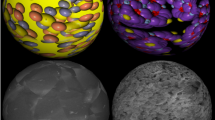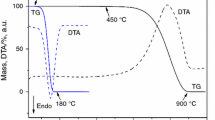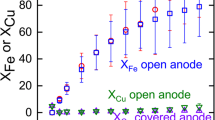Abstract
In sodium fast reactors (SFR), dissolved oxygen in sodium can be monitored via potentiometric sensors with an yttria-doped thoria electrolyte. Yttria-doped ceria (YDC) was chosen as a surrogate material to validate the process of such sensors. The material must exhibit high density and a fine grain microstructure to be resistant to the corrosion by liquid sodium and thermal shocks. Thus, the oxalic co-precipitation route was chosen to avoid milling steps that could bring impurity incorporation which is suspected to induce grain boundary corrosion in sodium. The powder and sintered pellets examination show that the synthesis conditions are of primary importance on the process yield, the oxalate powder microstructure and, eventually, on the ceramic density and microstructure. The impurity content was limited by controlling the synthesis, calcination, and sintering steps.




Similar content being viewed by others
References
L. Brissonneau, J. Nucl. Mater. 423, 67–78 (2012)
R. Thompson, R.G. Taylor, R.C. Asher, C.C.H. Wheatley, and R. Dawson: LIMET Liquid Metal Technology, Richland, 1980
R. Ganesan, S. Vivekanandhan, T. Gnanasekaran, G. Periaswami, R.S. Srinivasa, J. Nucl. Mater. 325, 134–140 (2004)
J. Van Herle, T. Horita, T. Kawada, N. Sakai, H. Yokokawa, M. Dokiya, Cer. Int. 24, 229–241 (1998)
S.K. Tadokoro, T.C. Porfirio, R. Muccillo, E.N.S. Muccillo, J. Power Sources 130, 15–21 (2004)
N. Hingant, N. Clavier, N. Dacheux, N. Barre, S. Hubert, S. Obbade, F. Taborda, F. Abraham, J. Nucl. Mater. 385, 400–406 (2009)
G. Bryan Balazs and R.S. Glass, SSI, 1995, vol. 76, pp. 155–62
M. Coduri, M. Scavini, M. Allieta, M. Brunelli, and C. Ferrero: J. Phys. Conf. Ser., 2012, pp. 012056–66
J. Van Herle, T. Horita, T. Kawada, N. Sakai, H. Yokokawa, M. Dokiya, J. Eur. Ceram. Soc. 16, 961–973 (1996)
S.L. Wang, J.Y. Liu, J.T. Jia, C.S. Liao, C.H. Yan, J. Rare Earths 26, 127–130 (2008)
J. Van Herle, T. Horita, T. Kawada, N. Sakai, H. Yokokawa, M. Dokiya, J. Am. Ceram. Soc. 80, 933–940 (1997)
S.K. Tadokoro, E.N.S. Muccillo, J. Alloy. Compd. 374, 190–193 (2004)
Author information
Authors and Affiliations
Corresponding author
Additional information
Manuscript submitted December 18, 2015.
Rights and permissions
About this article
Cite this article
Brissonneau, L., Mathieu, A., Tormos, B. et al. Microstructure of Yttria-Doped Ceria as a Function of Oxalate Co-Precipitation Synthesis Conditions. Metallurgical and Materials Transactions E 3, 264–271 (2016). https://doi.org/10.1007/s40553-016-0087-8
Published:
Issue Date:
DOI: https://doi.org/10.1007/s40553-016-0087-8




